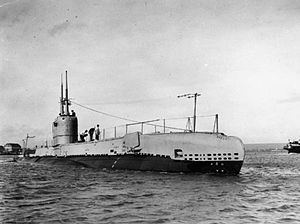Name HMS Seahorse Length 62 m Draft 3.63 m | Fate Sunk 7 January 1940 Launched 15 November 1932 Test depth 91 m | |
 | ||
Displacement 730 long tons (740 t) surfaced927 long tons (942 t) submerged | ||
HMS Seahorse was a first-batch S-class submarine (often called the Swordfish class) built for the Royal Navy during the 1930s. She lost at sea with all hands in 1940.
Contents
Design and description
The S-class submarines were designed as successors to the L class and were intended to operate in the North and Baltic Seas. The submarines had a length of 202 feet 6 inches (61.7 m) overall, a beam of 24 feet (7.3 m) and a mean draft of 11 feet 11 inches (3.6 m). They displaced 730 long tons (740 t) on the surface and 927 long tons (942 t) submerged. The S-class submarines had a crew of 38 officers and ratings. They had a diving depth of 300 feet (91.4 m).
For surface running, the boats were powered by two 775-brake-horsepower (578 kW) diesel engines, each driving one propeller shaft. When submerged each propeller was driven by a 650-horsepower (485 kW) electric motor. They could reach 13.75 knots (25.47 km/h; 15.82 mph) on the surface and 10 knots (19 km/h; 12 mph) underwater. On the surface, the first-batch boats had a range of 3,700 nautical miles (6,900 km; 4,300 mi) at 10 knots (19 km/h; 12 mph) and 64 nmi (119 km; 74 mi) at 2 knots (3.7 km/h; 2.3 mph) submerged.
The boats were armed with six 21-inch torpedo tubes in the bow. They carried six reload torpedoes for a grand total of a dozen torpedoes. They were also armed with a 3-inch (76 mm) deck gun.
Construction and career
HMS Seahorse was built by Chatham Royal Dockyard and launched on 15 November 1932. At the onset of World War II, Seahorse was a member of the 2nd Submarine Flotilla. From 23-26 August 1939, the 2nd Submarine Flotilla transferred to its war base, Dundee and Blyth. On 26 December 1939 she sailed from Blyth for patrol off the east coast of Denmark. Four days later she shifted position to the entrance of the Elbe. She did not return on her due date of 9 January 1940. It was first thought that she had been mined but German records, examined after the war, suggest she was the victim of the German First Minesweeper Flotilla which reported a sustained depth charge attack on an unidentified submarine on 7 January 1940. It is however also possible that she was rammed and sunk by the German Sperrbrecher IV/Oakland south east of Helgoland on 29 December 1939.
